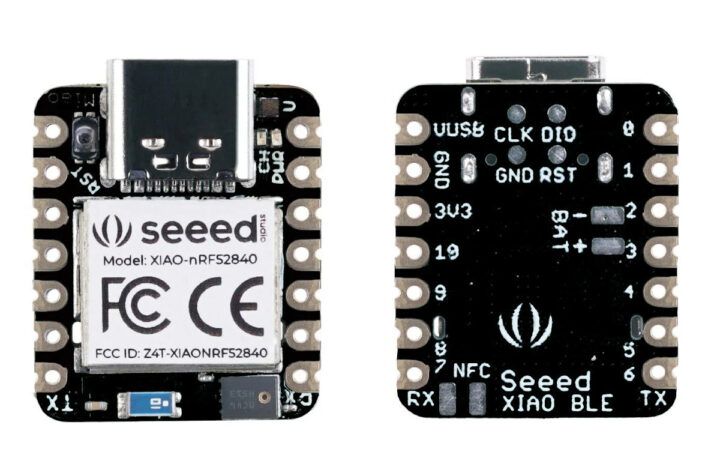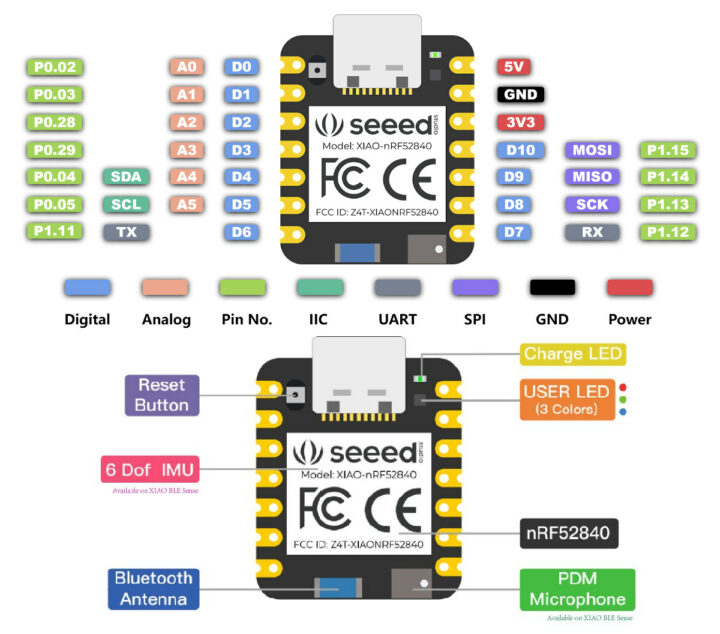Seeed Studio has just introduced two new members to their XIAO board family with the Seeed XIAO BLE and XIAO BLE Sense boards equipped with Nordic Semi nRF52840 Bluetooth 5.0 microcontroller, as well as an IMU sensor and microphone on the “Sense” model.
Just like the earlier XIAO RP2040 board, the tiny Seed XIAO BLE board can be programmed with Arduino, MicroPython, and CircuityPython, and offers two headers with 7-pin each for GPIOs. What’s really new is the wireless connectivity, the sensors, and a battery charging circuitry.
 Seeed XIAO BLE specifications:
Seeed XIAO BLE specifications:
- Wireless MCU – Nordic nRF52840 Arm Cortex-M4F microcontroller @ up to 64 MHz with 1 MB flash, 256 KB SRAM, Bluetooth 5.0, NFC, Zigbee connectivity
- Storage – 2 MB QSPI flash
- Expansion I/Os
- 2x 7-pin headers with 1x UART, 1x I2C, 1x SPI, 1x NFC, 1x SWD, 11x GPIO (PWM), 6x ADC
- 3.3V I/O voltage (not 5V tolerant)
- Sensors (XIAO BLE Sense only) – Onboard PDM digital microphone, onboard 6-axis IMU (LSM6DS3TR)
- Misc – Reset button, 3-color LED, charging LED
- Power Supply
- 5V via USB Type-C port
- BQ25101 battery charging chip
- Operating voltage 3.3V@200mA
- Charging current: 50mA/100mA
- Standby power consumption: < 5μA
- Dimensions – 21 x 17.5mm
Another difference compared to the earlier boards is support for TinyML using Tensorflow Lite and/or Edge Impulse, at least for XIAO BLE Sense board with audio and motion-sensing capabilities. Sadly, I could not find any documentation for the board at this time, but it should soon become available on Seeed Studio Wiki.
Both versions of the boards are up for pre-order with shipping expected to start on December 15th. Seeed XIAO BLE board goes for $9.99, while the XIAO BLE Sense sells for $15.99.

Jean-Luc started CNX Software in 2010 as a part-time endeavor, before quitting his job as a software engineering manager, and starting to write daily news, and reviews full time later in 2011.
Support CNX Software! Donate via cryptocurrencies, become a Patron on Patreon, or purchase goods on Amazon or Aliexpress







Looks fairly complete in terms of I/O, and there’s not even one square millimeter of wasted space on the board! It could easily find its way in plenty of toys.
Does this also support mbed, or some other C/C++ sdk or rtos?, not realy a fan of arduino or python.
Considering that Arduino support for nano 33 BLE (nRF52840) is completely based on mbed, I wouldn’t be surprised if Arduino support for these boards is also built upon mbed.
The nRF52 series is well supported with Zephyr, Mbed, RIOT, and lots of others I forgot. All you should need to do is set the pin definitions.
The TP1,2,3,5 are connected to the SWD interface, so the board should be programable with a SWD/JTAG programmer to replace the bootloader and softdevice firmware (meaning it should work with Zephyr or the Nordic SDK). Hopefully they actually tested it at 5uA rather than just reporting the nrf52 specs. I see the LC filter for the DC/DC converter on the schematic, but I’ve seen that other inexpensive modules have difficulty hitting the low-power specs. IT is definitely an interesting looking board.